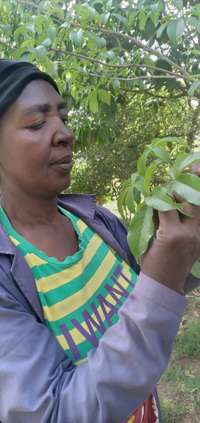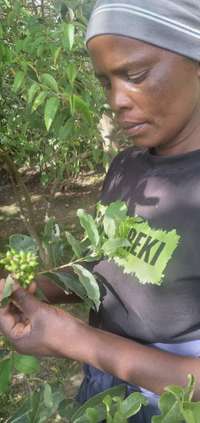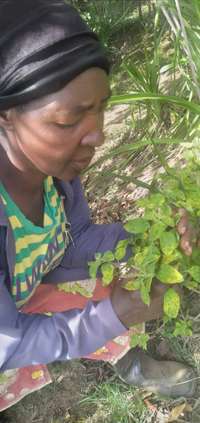ECHO’s missions is to reduce hunger and improve lives worldwide through partnerships that equip people with agricultural resources and skills. One of the ways ECHO addresses this is through the promotion of holistic farming methods and appropriate technologies. However, it would be imprudent to ignore the role that wild foods have in rural areas and their potential as important nutrient-rich supplements let alone their potential economic value.
This article supplements a rich array of resources already available on ECHOcommunity.org about wild foods. It challenges ECHO’s network members to utilize wild and traditional foods which are often richer in nutrients and easier to access when conceiving programs to impact poor households. We would like to raise the following lead questions, and to follow later with questions seeking readers’ feedback.
Leading Questions:
- Can the poor’s resilience improve by higher reliance on wild foods, not only during famines and dry seasons but throughout the year?
- Will this effort reduce hunger and nutrient deficiencies?
- Can it impact biodiversity in a positive way through the conservation of wild areas and species?
This article addresses some of these questions but may pose more questions than it answers.

Figure 1. Mama Zablon harvesting baobab leaves. Source: Erwin Kinsey
For some of us, the utilization of wild foods is a romantic activity that conjures up emotions of being “close to the Earth”. As a child, one of my favorite activities with my second cousin was to camp out, imagining we were Abnaki ‘Indians’ at a nearby secluded beaver pond. We would gather and boil up delectable early seasonal vegetables from the wild —fiddle-head ferns, sorrel, milkweed tops, and more— before they were too mature and bitter. Few things delighted like roadside green apples with salt to cover their sourness, or wild strawberries, blueberries, currants, gooseberries, raspberries, and blackberries in the Vermont woods.
As an adult living in Tanzania in the early 80’s, my wife supplemented our family’s diet with vegetables now considered to be traditional African vegetables (TAV) such as Spider plant (Cleome gynandra), Amaranth (Amaranthus sp.), African nightshades (Solanum scabrum) and (S. villosum), Sweet potato roots and vines (Ipomea batatas), pumpkin leaves, seeds, and fruits (Cucurbita sp.), African bitter eggplant (S. macrocapon), and African okra (Abelmoschus esculentus). In addition, I have enjoyed the following wild foods on excursions into wild areas of Tanzania:
- Desert date — Balanites aegyptiaca,
- Baobab fruits — Adansonia digitata,
- Kei apples — Dovyalis caffra,
- Marula fruits — Sclerocarya birrea,
- African Horned Melon — Cucumis metuliferus,
- Tamarind pods — Tamarindus indicus, and
- Sour plum — (Ximenia caffra and X. americanum).

Figure 2. Mama Jessica harvesting undushibi (Cordia sinensis.) Source: Erwin Kinsey
There are people who still obtain most of their sustenance from wild foods. While foraging in the Western societies is normally a hobby of aficionados, in many African societies it is a vital source of dietary staples and supplements, especially during drought and food insecurity. During the First World War, the Germans outwitted the British for their high reliance on their Tanzanian porters’ knowledge of wild edible plants to stave off hunger in the bush. 1 Webster’s definition of ‘wild foods’ includes those flora and fauna growing in nature without the aid of man. This definition does not necessarily limit to indigenous species, but includes those foods able to be foraged of which many species have gone wild/feral all over the world.
A report from IRIN affirms the potential for use of wild foods to improve nutrition and food security among the world’s poor. The article describes the benefits and potentially larger role of nutrient-rich, forest-derived foods such as berries, bush meat, roots, insects, and nuts.
In his book Hadzabe - by the Light of a Million Fires (2013), Daudi Peterson shares a sample from over 800 known edible plant and animal/insect species consumed by the Hadzabe people. This small ethnic group of less than 1,500 people are among the last remaining hunter-gatherers of East Africa who still live in their original homeland. ECHO East Africa staff recently asked Susanna Naftal, an exceptional Hadza woman educated through secondary school and having a desire to safeguard her people’s livelihoods and knowledge base, to share her knowledge regarding the importance of wild foods. Table 1 describes seven plants which are staples among her people, how they were once prepared, and how they are consumed. She also described other starchy roots which also are staples.
| Hadzabe Plant Staple Food | Preparations | When harvested | Other comments | Listed in Ethiopian Famine Food Field Guide | |||
|---|---|---|---|---|---|---|---|
| Plant name | Part consumed | Leaves | Seeds | Fruits | |||
| Mbuyu = Baobab Adansonia digitate |
Leaves (Figure 1), seeds, immature stems | Crushed & Boiled, or heated over fire | Soak in cold water, stir or squeeze juice, or pound seeds to powder for paste; oil can be extracted | Fruit can be sucked from seeds | Leaves in rainy season; seeds in dry season | Is most desired staple; seeds can even be recovered from baboon feces | Yes, extensively described; also on Wikipedia |
| Kongorobi Grewia bicolor |
Fruits | Nil | Nil | Fruits eaten fresh are very sweet | Obtained in wet season May - June | Loved by all | Yes, and extensively described on ICRAF’s website |
| Nguilabe Grewia capitellata |
Fruits | Nil | Nil | Fruits squeezed by hand into a juice, drunk fresh | Obtained in late wet season May-June | Loved by all | Not cited; cited but not described on Wikipedia. |
| Undushibi = Mdabi (Ksw) Cordia sinensis |
Fruits (Figure 2) | Nil | Nil | Fruits collected fresh or dry on plant, drunk fresh | Obtained in late wet season May-June | Loved by all | Yes, extensively described; also on Wikipedia. |
| Musakabi Cordia crenata |
Fruits | Nil | Nil | Fruits collected fresh, or dried on plant & soaked, squeezed and drunk fresh | Obtained in late wet season May-June | Not very popular; consumed when needed | Cited, perhaps synonym with Cordia edulis; not described per se on either website. |
| Mlenda = Jute mallow Corchorus olitorius |
Leaves (Figure 3) | Boiled quickly or heated over fire & salted; may be ground before cooking | Nil | Nil | Obtained all year round | Very popular; useful medicine for weak knees or fluid retention | Yes, extensively described; also on Wikipedia. |
| Tafabe Salvadora persica |
Fruits | Nil | Nil | Fruits squeezed by hand into a juice, drunk fresh | Early rains in January or February | Good medicine for the liver and stomach; liked by all | Yes, extensively described; also on Wikipedia. |

Figure 3. Elias weeding Jute mallow. Source: Erwin Kinsey
Traditionally, the Hadzabe, eat these plants uncooked or with minimal processing. Occasionally, wild foods are roasted over open fires, i.e., without pans or skillets but mostly raw with minimum processing. This has changed recently to some extent, depending on preferences within family clusters and their proximity to outside influence, but overall their approach to food preparation and consumption leaves a very light footprint on the earth. They continue to kill only what game they can consume, and are accustomed to sharing all things without hoarding or sense of ownership. A different study, The Human Food Project, explores and extols the advantages of the Hadza’s high fiber, diverse microbial, hunter-gatherer diet, and how it informs changes needed in western diets.
Most African fruits are wild and have not been ‘tamed’ out of over 1,000 fruit-bearing plants in Africa alone. Despite the key role that wild fruits can play during times when food is scarce, few wild fruits are considered in food security initiatives or development projects. They may be consumed raw, dried, or processed into flour or pastes, and are easily propagated from seeds or cuttings. Many have potential to be explored further to improve diets and help preserve natural areas.
A PhD dissertation by Silvia Ceppi in Tanzania (see Silvia Ceppi -phd thesis) compares the relative footprints of diets based upon 10 different ethnic groups in Tanzania, home to over 120 ‘tribes’ and numerous ‘subtribes’. The publication discusses various sources of wild foods, including wild fruits, mushrooms, and bush meat with fascinating findings. For example, during times of famine, those consuming wild foods and indigenous fruits most frequently are children while herding animals. Ceppi notes that wild foods are not consumed in significant quantities, but their contribution to nutritive value in the diets is significant, particularly in the ‘miombo’ woodlands which host the highest number of edible fruit bearing tree species in Tanzania. The fruits from these trees are normally available during dry season and contribute to mitigation of food shortages. The paper quotes wider research showing the importance of dark leafy greens for two to five year-old children for several micronutrients. The role of green leaf consumption is important in starch-based diets as well as communities with the least access to fresh green leaves such as the pastoralist Maasai. The downside of wild foods is the loss of wildlife and environmental impact from bush meat consumption which has selective severity on some threatened species. The paper examines the factors influencing predation by humans on a range of 25 categories of bush meat such as antelopes, the most accessible type of illegally harvested meat, and small species like Cane rat and Guinea fowl which dominate in other areas.

Figure 4. Mama Zablon harvesting wild African Basil. Source: Erwin Kinsey
Dependency on wild foods is usually seasonal. For example, across ethnic groups in Tanzania during the food scarce period of the early long rains in March when weeding farms is the only casual labor coping opportunity, families often increase their intake of green wild foods and wild fruits. In drier central Tanzania families commonly collect green immature baobab fruits to boil and eat, and later gather grasses resembling finger millet to pound into flour for porridge.
.jpg?w=200)
Figure 5. Mama Jessica harvesting wild fig fruits (Ficus sycamores). Source: Erwin Kinsey
In Africa and within ECHO, other publications are obtained on wild foods. The Famine Food Field Guide website cited in table 1 is based upon collections in Ethiopia. This fascinating website describes four major categories of ‘wild-food’ plants: (1) typical ‘famine-food’ plants, (2) ‘wild-food’ plants with ‘famine-food’ components, (3) ‘wild-food’ plants attracting additional consumer categories during food shortage periods, and (4) on-farm food crops with ‘famine-food’ components. In the categories, local names, descriptions, parts consumed, preparation methods, and some typical representative examples of ‘wild-food’ plants are described.
An abundance of books are found on foraging in North America, Europe, and other areas. Fewer publications exist for the Global South where reliance on wild foods is higher. Publications such as those cited below are available for further research, and could be a valuable addition to this article if readers will contribute their favorites.
Knowledge of the use of wild foods is a valuable heritage to be passed on from generation to generation and an important contribution to reducing biodiversity affecting the planet. Biodiversity loss among foods is the subject of another article!
Seeking Feedback: We would like to get feedback from ECHO readers to know:
Please submit feedback through this online forum conversation:
- What do you think should be ECHO and partners’ role in promoting wild foods? Is it simply sharing knowledge?
- Should ECHO improve its network members’ access to wild foods which may be underutilized?
- Should ECHO store and share seeds and planting materials of wild foods in demonstration gardens to make them more affordable and acceptable for promotion than other conventional food options?
- Will the promotion of wild foods favorably impact biodiversity and the conservation of wild areas and species?
- Do wild foods have a place in the food security work you do either as a development worker, or as a provider of diverse foods for your family?
References
Ceppi, S. L.. 2013. Nutritional and environmental sustainability of the diets of ten ethnic groups in ten tanzanian ecoregions. (Unpublished doctoral dissertation). Cardiff Metropolitan University, UK.
Famine Food Field Guide: Ethiopia. https://www.africa.upenn.edu/faminefood/fieldguide.htm accessed January 1, 2023.
Human Food Project. https://www.hyperbiotics.com/blogs/recent-articles/jeff-leach-founder-of-the-human-food-project. Accessed January 19, 2023.
Naftal, S. 2014. Personal Communication.
Paice, E.. 2007. Tip and Run: The Untold Tragedy of the First World War in Africa. Weidenfeld & Nicolson.
Peterson, D.. 2013. Hadzabe - by the Light of a Million Fires. Mkuki na Nyota Publishers.
Further Reading:
Berkelaar, D. 2018. Green Leafy Vegetables. ECHO Development Notes no. 141.
Berkelaar, D. 2009. Baobab gardens for leaf production. ECHO Development Notes no. 103.
Bharucha Z and J.N. Pretty. 2010. The roles and values of wild foods in agricultural systems. PubMed. 365(1554):2913-26.
Coursey, D.G. 1976 The origins and domestication of yams in Africa in Harlan. In: West Africa Culture Dynamics.
DeVynk, J., B.E. VanWyk , and R.M Cowling. 2016. Indigenous edible plant use by contemporary Khoe-San descendants of South Africa’s Cape South Coast. South African Journal of Botany. 102:60-69.
Dubois, T.. 2018. The importance of traditional vegetables in drylands [http://edn.link/w642nf] and Traditional Africa Vegetables describes the World Vegetable Center’s work with traditional African foods, some indigenous, some ‘naturalized’, which have become common cuisine of rural Africans. The WVC is doing plant selection for desirable traits of flavor, productivity, insect resistance, and sharing seeds with research and development partners, including ECHO.
FAO. 1968. An index of edible African plants http://www.fao.org/3/X6877E/X6877E23.htm#ap4 incorporated into its ‘Food Composition Tables for Use in Africa.
Fifer G. 2018. Underutilized Crops for Small Farm Abundance. ECHO Technical Note no. 91 [http://edn.link/tn91] describes many of ECHO’s favorite nutrient dense under-utilized plants from around the world.
Harlan, J.R.. 1976. Origins of African Plant Domestication, p. 383-408. Mouton Publishers: The Hague.
Harkonen M., T. Niemela, and L. Mwasumbi. 2003. Tanzanian Mushrooms: Edible, Harmful and Other Fungi published by Finnish Museum of Natural History is a marvelously illustrated book on East Africa edible mushrooms with good color photos and cautions about the poisonous varieties with photos as well.
Harlan, J.R.. 1997. Food crops In Vogel JO, Encyclopedia of Precolonial Africa, pp. 225-227. Walnut Creek, CA: AltaMira Press.
Harlan, J.R. 1993. The tropical African cereals in Shaw T et. al., The Archaeology of Africa: Food, Metals and Towns, p. 53-60. One World
Archaeology 20, Routledge:New York.
Kajembe G, M. Mwenduwa, J. Mgoo, and H. Ramadhani. 2000. Potentials of Non-Wood Forest Products in Household Food Security in Tanzania: The Roles of Gender Based Local Knowledge.
Kingsolver, B.. 2008. Animal, Vegetable, Miracle – describes foraging and experiencing local foods in America.
Martin F.W., R.M. Ruberte, and L.S. Meitzner. 1998. Edible leaves of the Tropics [http://edn.link/yt6d2r]. ECHO Inc.
Martin F.W., C.W. Campbell, and R.M Ruberte. 1987. Perennial edible fruits of the Tropics : an inventory - chapter 5 lists the ‘Minor fruits of Africa’.
McIntosh, R.J.. 1997. Agricultural beginnings in Sub-Saharan Africa in Vogel JO, Encyclopedia of Precolonial Africa, pp.409-417. Walnut Creek, CA: AltaMira Press.
National Research Council, Policy & Global Affairs, Development, Security and Cooperation: 3 volumes:
- (1996) Lost Crops of Africa Volume I Grains: http://edn.link/yt2464
- (2006) Lost Crops of Africa Volume II Vegetables: http://edn.link/dd5363e
- (2008) Lost Crops of Africa Volume III Fruits: http://edn.link/qwpz6h
Phillipson, D.W. 1993. The antiquity of cultivation and herding in Ethiopia in Shaw T et. al., The Archaeology of Africa: Food, Metals and Towns, p. 344-357. One World Archaeology 20, Routledge:New York.
Pollan, M. 2006. The Omnivore’s Dilemma – the last chapter describes foraging in parts of America. What some thought was a lost art is thriving among the avid and locally knowledgeable.
Porteres, R. 1976. African cereals: Eleusine, Fonio, Black Fonio, Teff, Brachiaria paspalum, Pennisetum, and African Rice.
Powell, B., P. Maundu, H.V. Kuhnlein, and T. Johns. 2013. Wild foods from Farm and Forest in the Eastern Usambara Mountains, Tanzania. Ecology of Food and Nutrition. 52:6, 451-478.
Purseglove, J.W.. 1976. The origins and migrations of crops in tropical Africa in Harlan JR et. al., Origins of African Plant Domestication, p. 291-310. Mouton Publishers: The Hague.
Shava, S. 2005. List of popular wild food plants of Zimbabwe University of South Africa. unisa, Department of Science and Technology Education.